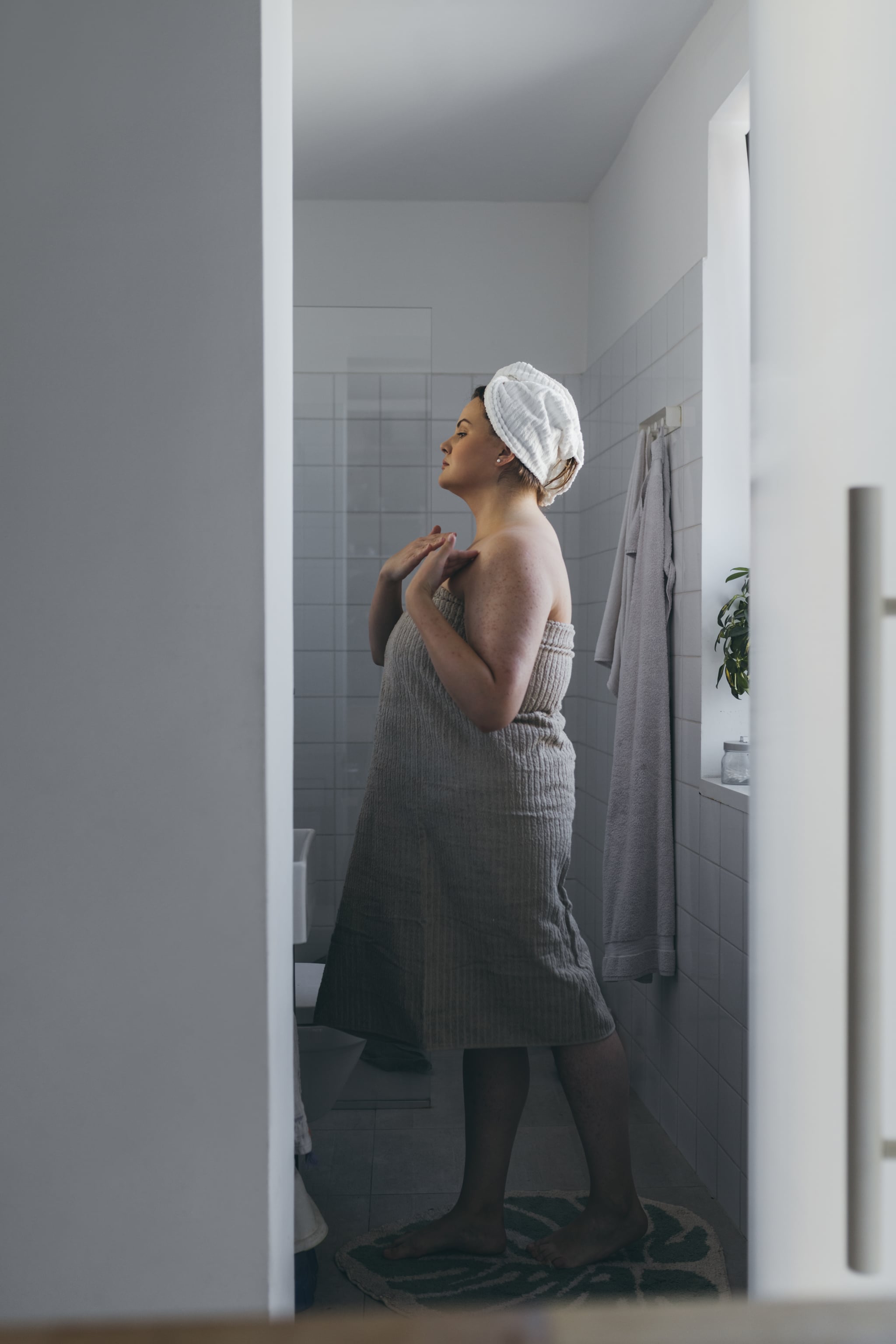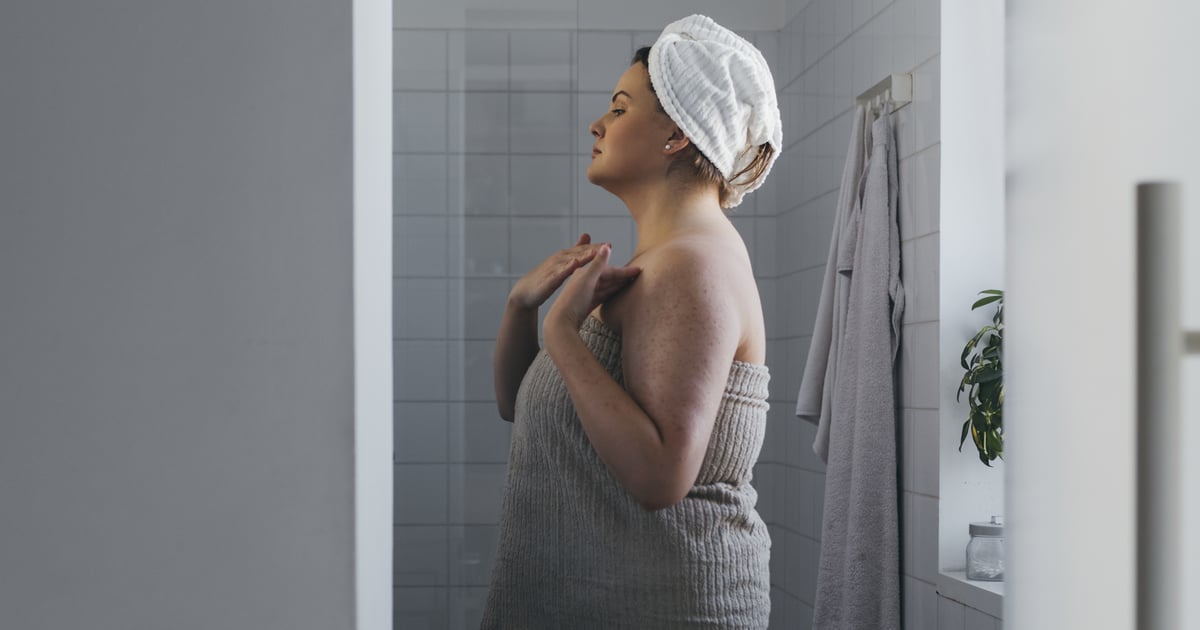
Picture this: You’ve just indulged in a long, relaxing shower, only when it comes time to towel off afterward, you find that your skin didn’t enjoy the experience as much as you did. Splotchy, red, irritated patches of skin crop up on various parts of your body, and you wonder how you could be having this reaction when the only things you’ve come in contact with are water and soap. There could be a few culprits behind these common post-shower skin reactions. Perhaps it’s a sign of dry skin or the results of using a dull razor blade. Rashes can also stem from skin conditions like irritant contact dermatitis, when the skin becomes red or sore from an irritating substance. POPSUGAR consulted dermatologists to help figure out what exactly causes rashes that occur in the shower, and what’s the best way to treat them.
Why Do I Have a Rash After I Shower?
Rashes that develop in the shower can be a sign of extremely dry skin. “Xerosis cutis, which is dry skin, is one of the most prominent causes for development of a rash after taking a shower,” board-certified dermatologist Michele Green, MD, told POPSUGAR. “This is because a high water temperature can strip the skin of the natural oils that keep it healthy and moisturized, causing it to become itchy.”
If the temperature of the water is too hot, that can also cause a skin rash. “If a rash develops after taking a shower due to the temperature of the water being too high, it is common to experience symptoms such as redness, swelling, itching, flaking, or even peeling,” Dr. Green explained.
Shaving habits are another culprit. “Using old razor blades and shaving can cause folliculitis — the inflammation of hair follicles,” board-certified dermatologist Marina Peredo, MD, FAAD, told POPSUGAR. “If the blade is dull, it will irritate the skin.”
Do Certain Skin Conditions Get Worse in the Shower?
Preexisting skin conditions can also play a role in rashes that appear post-shower. “Irritant contact dermatitis can cause the skin to become dry from taking hot showers,” Dr. Peredo said. This skin disorder in particular can become aggravated during a shower routine. “The combination of hot water, fragrant soaps, and skin that isn’t moisturized can make skin red, dry, and cracked.”
Both Dr. Peredo and Dr. Green agree that cholinergic urticaria can also cause a rash after showering. “Cholinergic urticaria is caused by nerve fibers in the sweat glands,” Dr. Peredo said. “If you take a hot shower, your body temperature goes up, which can create hives.”
The soap you use and the temperature of the shower itself can also make rashes appear for those who have eczema. “Eczema can be triggered by substances that come in contact with the skin, such as soaps, cosmetics, clothing, detergents, jewelry, or sweat,” Dr. Green said. “Someone who struggles with eczema may experience a flare after taking a hot shower.”
How Can I Treat a Shower-Induced Rash?
Changing the temperature of your shower is a great place to start when trying to avoid rashes. “Keep the temperature of the water on the cooler side to help keep away any unwanted itching, redness, or discomfort,” Dr. Green said. A warmer shower is also much better for those with skin conditions. “Taking shorter, cooler showers are good for irritant contact dermatitis and cholinergic urticaria,” Dr. Peredo advised.
Keeping skin hydrated is another simple fix. “If your skin is dry, it’s important to use a rich moisturizer that can strengthen the natural barrier of your skin,” Dr. Green said. Dr. Peredo suggests moisturizing skin while it’s still wet, so the lotion or oil gets a better chance to absorb properly. For those with extremely dry skin, it’s best to consult with your dermatologist about a more personalized treatment plan. “In extreme cases of dry skin, your dermatologist can prescribe topical steroid creams like hydrocortisone cream to reduce redness and inflammation,” Dr. Green said. “Oral antihistamines like Benadryl, Zyrtec, or Claritin may also be needed to help alleviate any pruritic symptoms associated with your dry skin.”
Soothe symptoms of a shower rash by cooling your skin down. “Using a humidifier and a cold-water compress can help soothe symptoms of the rash that appear after taking a hot shower,” Dr. Green suggested.
How Can I Prevent Rashes That Develop in the Shower?
Creating regular habits for more hydrated, moisturized skin will reduce dryness and lessen the chance of developing a rash after the shower. “Apply a soothing, unscented body lotion to skin twice a day to keep skin well moisturized and prevent irritation,” Dr. Green said. “If you have dry skin, be sure to stay hydrated and drink plenty of water throughout the day in order to maintain healthy and moisturized skin.”
Swapping out body soap, shampoo, and skin-care products might also prevent shower rashes. “Stick to gentle soaps that don’t have a fragrance to ensure that your rash is not an allergic reaction to an ingredient in your hygiene products,” Dr. Green advised. “Skip using skin-care products that contain potentially irritating ingredients like alpha hydroxy acids (AHAs), beta hydroxy acids (BHAs), retinols, or retinoids. These ingredients are designed to increase the rate of skin-cell turnover and can be a cause for dry skin.”
If rashes are developing after you shave in the shower, it could be time for a new razor. “Replace dull razor blades with new ones to help prevent folliculitis,” Dr. Peredo said.
It’s also important to be mindful of how you dry off after the shower. “Instead of rubbing your skin with a towel to dry after showering, gently pat the skin with a towel to prevent irritation,” Dr. Green suggested.
